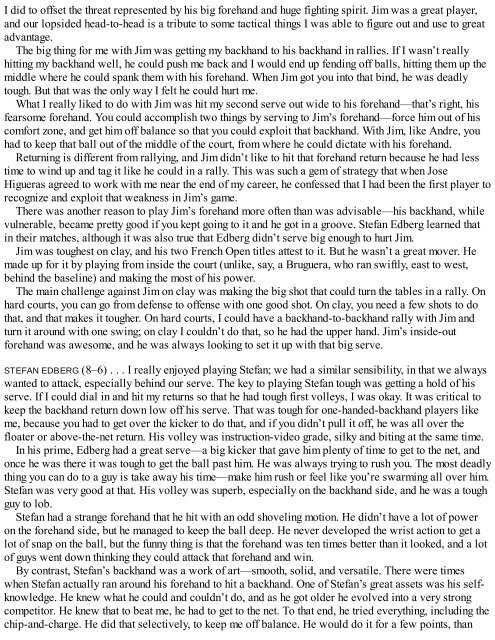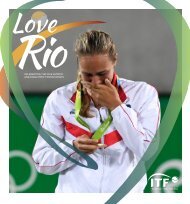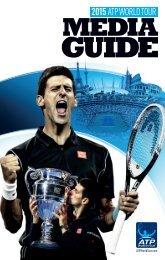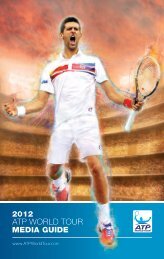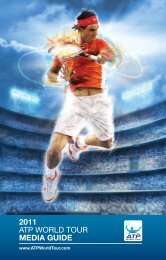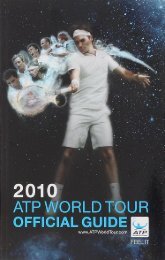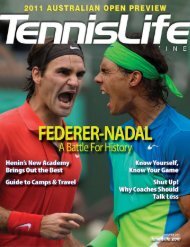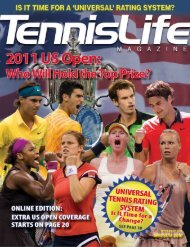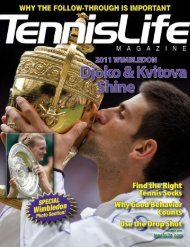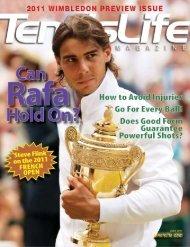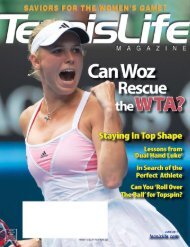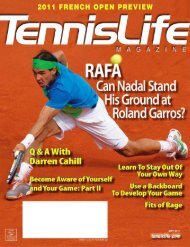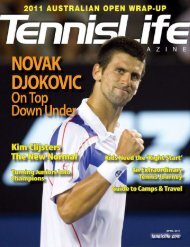A Champion's Mind - Pete Sampras
www.tennismoscow.me Insta:TENNISMOSCOW
www.tennismoscow.me Insta:TENNISMOSCOW
Create successful ePaper yourself
Turn your PDF publications into a flip-book with our unique Google optimized e-Paper software.
I did to offset the threat represented by his big forehand and huge fighting spirit. Jim was a great player,<br />
and our lopsided head-to-head is a tribute to some tactical things I was able to figure out and use to great<br />
advantage.<br />
The big thing for me with Jim was getting my backhand to his backhand in rallies. If I wasn’t really<br />
hitting my backhand well, he could push me back and I would end up fending off balls, hitting them up the<br />
middle where he could spank them with his forehand. When Jim got you into that bind, he was deadly<br />
tough. But that was the only way I felt he could hurt me.<br />
What I really liked to do with Jim was hit my second serve out wide to his forehand—that’s right, his<br />
fearsome forehand. You could accomplish two things by serving to Jim’s forehand—force him out of his<br />
comfort zone, and get him off balance so that you could exploit that backhand. With Jim, like Andre, you<br />
had to keep that ball out of the middle of the court, from where he could dictate with his forehand.<br />
Returning is different from rallying, and Jim didn’t like to hit that forehand return because he had less<br />
time to wind up and tag it like he could in a rally. This was such a gem of strategy that when Jose<br />
Higueras agreed to work with me near the end of my career, he confessed that I had been the first player to<br />
recognize and exploit that weakness in Jim’s game.<br />
There was another reason to play Jim’s forehand more often than was advisable—his backhand, while<br />
vulnerable, became pretty good if you kept going to it and he got in a groove. Stefan Edberg learned that<br />
in their matches, although it was also true that Edberg didn’t serve big enough to hurt Jim.<br />
Jim was toughest on clay, and his two French Open titles attest to it. But he wasn’t a great mover. He<br />
made up for it by playing from inside the court (unlike, say, a Bruguera, who ran swiftly, east to west,<br />
behind the baseline) and making the most of his power.<br />
The main challenge against Jim on clay was making the big shot that could turn the tables in a rally. On<br />
hard courts, you can go from defense to offense with one good shot. On clay, you need a few shots to do<br />
that, and that makes it tougher. On hard courts, I could have a backhand-to-backhand rally with Jim and<br />
turn it around with one swing; on clay I couldn’t do that, so he had the upper hand. Jim’s inside-out<br />
forehand was awesome, and he was always looking to set it up with that big serve.<br />
STEFAN EDBERG (8–6) . . . I really enjoyed playing Stefan; we had a similar sensibility, in that we always<br />
wanted to attack, especially behind our serve. The key to playing Stefan tough was getting a hold of his<br />
serve. If I could dial in and hit my returns so that he had tough first volleys, I was okay. It was critical to<br />
keep the backhand return down low off his serve. That was tough for one-handed-backhand players like<br />
me, because you had to get over the kicker to do that, and if you didn’t pull it off, he was all over the<br />
floater or above-the-net return. His volley was instruction-video grade, silky and biting at the same time.<br />
In his prime, Edberg had a great serve—a big kicker that gave him plenty of time to get to the net, and<br />
once he was there it was tough to get the ball past him. He was always trying to rush you. The most deadly<br />
thing you can do to a guy is take away his time—make him rush or feel like you’re swarming all over him.<br />
Stefan was very good at that. His volley was superb, especially on the backhand side, and he was a tough<br />
guy to lob.<br />
Stefan had a strange forehand that he hit with an odd shoveling motion. He didn’t have a lot of power<br />
on the forehand side, but he managed to keep the ball deep. He never developed the wrist action to get a<br />
lot of snap on the ball, but the funny thing is that the forehand was ten times better than it looked, and a lot<br />
of guys went down thinking they could attack that forehand and win.<br />
By contrast, Stefan’s backhand was a work of art—smooth, solid, and versatile. There were times<br />
when Stefan actually ran around his forehand to hit a backhand. One of Stefan’s great assets was his selfknowledge.<br />
He knew what he could and couldn’t do, and as he got older he evolved into a very strong<br />
competitor. He knew that to beat me, he had to get to the net. To that end, he tried everything, including the<br />
chip-and-charge. He did that selectively, to keep me off balance. He would do it for a few points, than


